
Drawings of the markings on the backs of my scarab bracelet cabochons. They’re supposed to be hieroglyphs, but I’m not so sure …
One of the things I mentioned in my first post about scarab bracelets is that on many of the bracelets in my collection — which are typical examples of 20th century pop culture bracelets — the underside of the cabochons are marked. What I’d heard (chatting to antique store proprietors mostly, but you also see it online) is that the marks are “hieroglyphs.”
The stones are intended to function as charms; the inscriptions confer luck or blessings on the wearer.
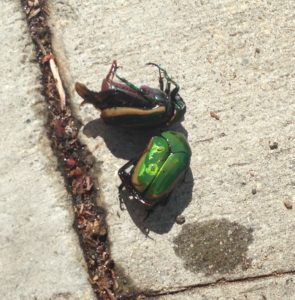
There are 30,000 species of Scarab beetles worldwide. I came across these (deceased… RIP pretty green beetles!) Fig Eater beetles a few weeks ago on the sidewalk by my house.
There’s some merit to the idea. The scarab itself is symbolic of pretty powerful stuff, although it’s not quite as straightforward as “it’s the good luck beetle.” Per this paper published by UCLA,
The scarab was used by the ancient Egyptians as a symbol of the rising sun being pushed across the sky (just as the beetle pushes balls of dung across the sand), exemplifying the notion that the sun god can create his own means of rebirth.
Bit of a leap from a symbol of the god Khepri/divine self-regeneration to “hope you win the lotto/get laid/avoid catching the flu this winter.” But the general idea is there: Wear scarab! Can’t hurt. Might help?
So what about the inscriptions?
“Genuine” scarab amulets — meaning museum quality / ancient Egyptian — had inscriptions carved on the back. There are some images in that UCLA paper of some of them, with translations. One inscription commemorates the building of a lake. Others are names. Here’s an edited version of a translation of an inscription that conferred a blessing; the inscription is the
… throne name of Thutmose III … [and] “the good god Menkheperra,” and below this an anx sign, meaning “may he live.” Menkheperra can also be read cryptographically as the name Amen-ra (sun disk).
“May he live” is a solid blessing to carry in your pocket for sure.
But fast forward to bracelets like the ones I own.
These aren’t ancient Egyptian amulets. They were made and sold in the 20th Century by costume jewelry makers.
People that bought them probably assumed that the markings on the back were hieroglyphs. But are they, really?
I did a bit of poking around the interwebs.
Logical first step: do an image search on Egyptian hieroglyphics to see if any of the symbols on the backs of my stones are obvious matches.
One of the things that seems pretty obvious, to my eye anyway, is that hieroglyphs are a completely different type of mark. They’re more pictorial, generally.
For example, here’s hieroglyphs from this online image next to my drawings of the marks on my bracelets. They really don’t look anything alike.
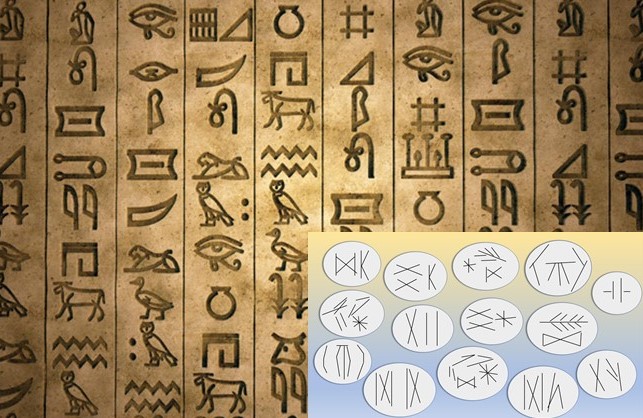 I combed through pages of Egyptian hieroglyphs. I didn’t find a single one that resembled the marks on my bracelets.
I combed through pages of Egyptian hieroglyphs. I didn’t find a single one that resembled the marks on my bracelets.
You’d expect, if the bracelet manufacturers were really trying, that they’d at least put an ankh on a couple of the stones, or an Eye of Horus. But nope.
Here’s another example, this one of cursive hieroglyphics from The Papyrus of Ani:
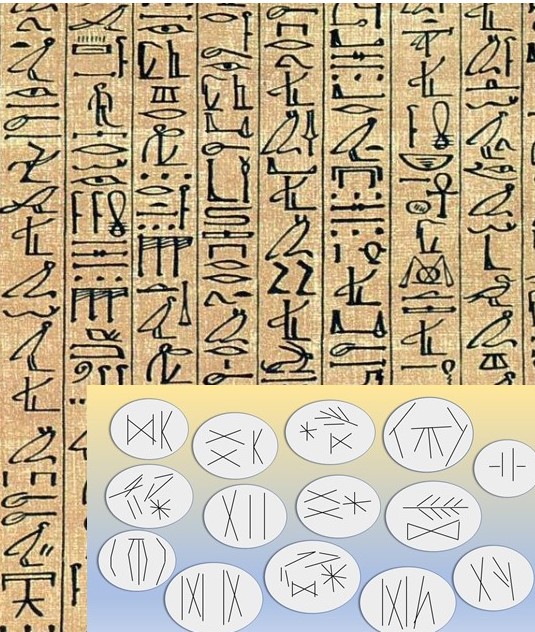 Arguably a little bit closer — but still a huge stretch to imagine any of the marks on any of my bracelets is a 1:1 for a mark on that piece of scroll.
Arguably a little bit closer — but still a huge stretch to imagine any of the marks on any of my bracelets is a 1:1 for a mark on that piece of scroll.
In fact, to my eye, the marks on my bracelets look more like kanji (Chinese characters) than Egyptian hieroglyphs. Japanese kanji are the closest to my eye. Here’s an image of Japanese kanji that I found on this site. There’s a pretty strong resemblance between these words and the marks on my bracelets — or anyway, stronger resemblance than to hieroglyphs …
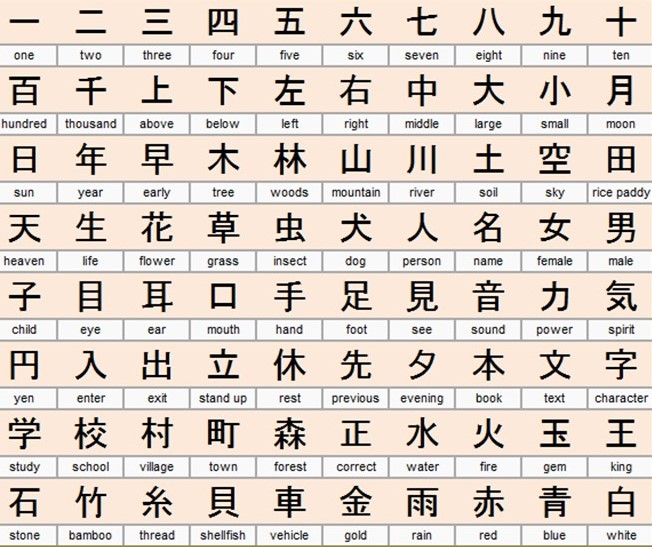 Which led me to Hypothesis #2:
Which led me to Hypothesis #2:
Maybe the stones were sourced from Asia, and maybe the people that carved them inscribed messages in Chinese or Japanese!
Oooh!!!!
Well. As it turns out, there are tools galore online that let you draw kanji and then display the English translation.
Tell you what, go play, if you have a scarab bracelet and think maybe the marks are kanji. But for my part, by the time I was done messing around on those tools for an hour or so, I started to feel a little foolish.
I wondered if I should even blog about this. I wondered if people who read and write Japanese wouldn’t find it laughable.
“Really? You thought the marks on my bracelets might be real words???”
So let me go out on a limb, here, with Hypothesis #3:
The marks on the backs of these bracelets are nonsense symbols.
They are random marks carved by stone workers who mass produced cabochons for US costume jewelry makers. They made simple marks, because simple marks are easy, and these were being mass produced after all.
The same marks show up on jewelry from different makers because makers often sourced their stones from common suppliers.
If you see any holes in my logic — or know of any evidence that either supports or refutes my latest/greatest hypothesis — drop me a line or leave a note in the comments.
Thanks for reading!
(And if you haven’t read my other posts on scarab bracelets, here is my first post, and here is my second.
Pssst. Are you a reader?
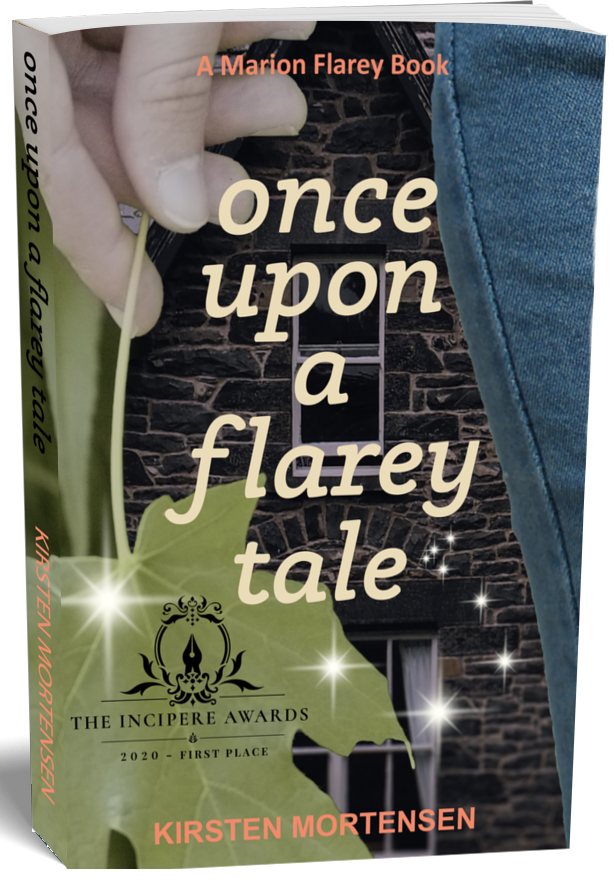
Meet Marion Flarey.
She’s out of a job.
Buried in school loan debt. About to be homeless.
And she’s no Rapunzel.
She doesn’t even have long hair.
But she just found an apartment.
And it has a Tower…
Once Upon a Flarey Tale.
Available on Amazon for Kindle or print, or click here to select from other e-formats.
Book 1 of my Marion Flarey Series.
Winner, 2020 Incipere Award for Women’s Fiction, Clean.

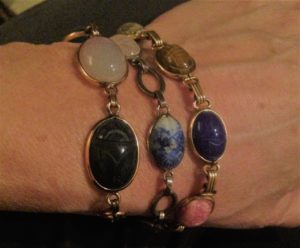
Well done, Kirsten!
I will send you more “substance” re my scarab bracelet soon! –Anne
Thanks, Anne, I look forward to it :)